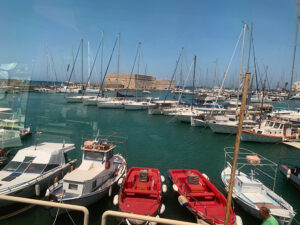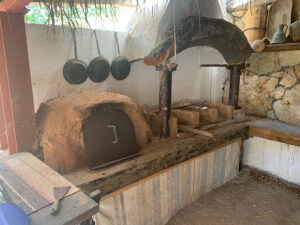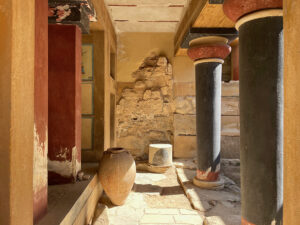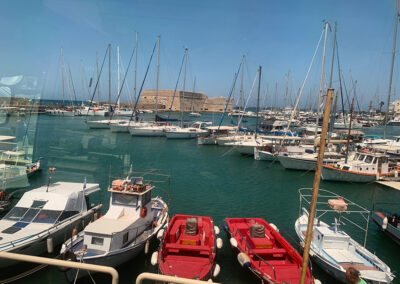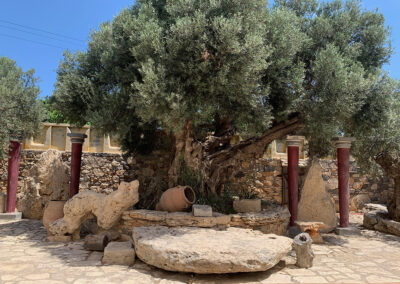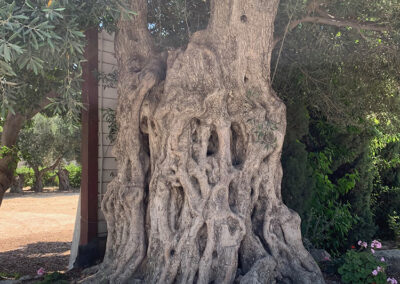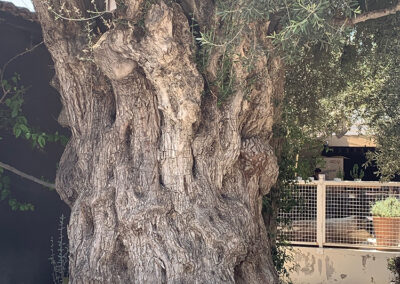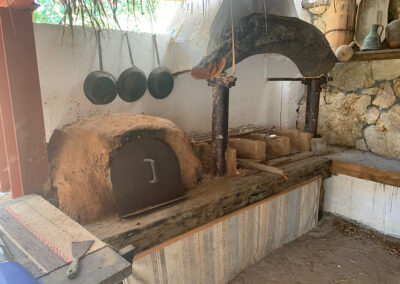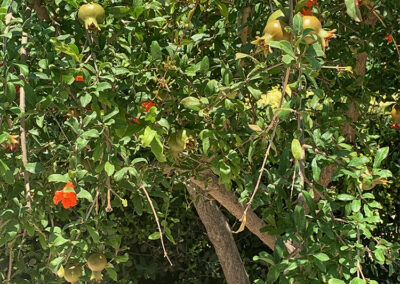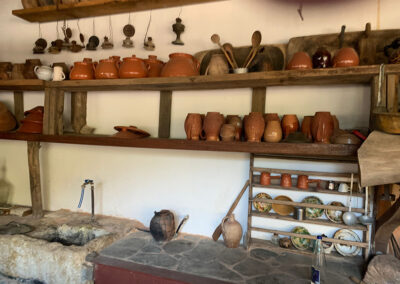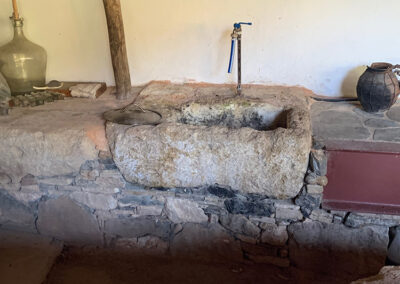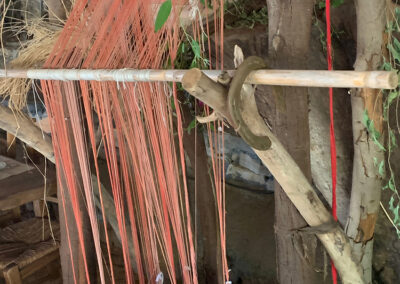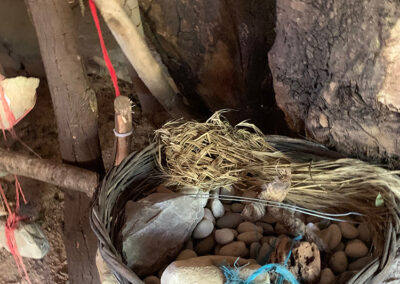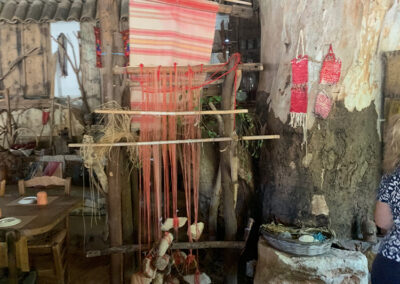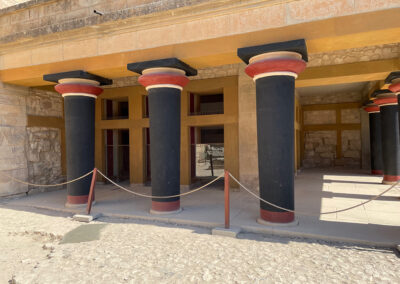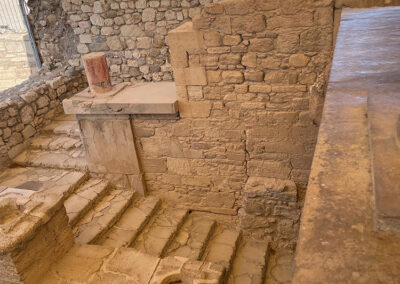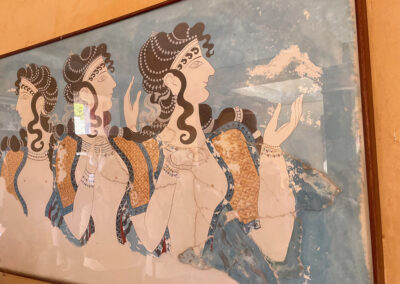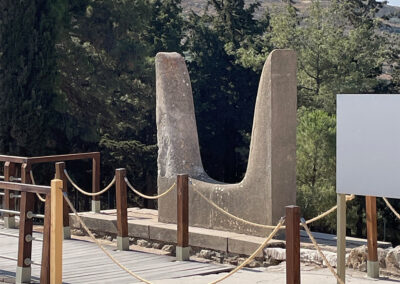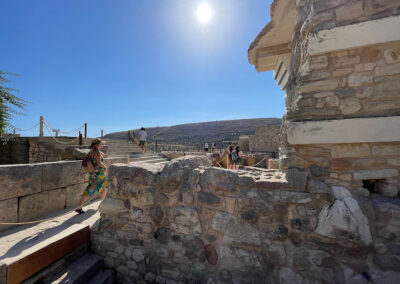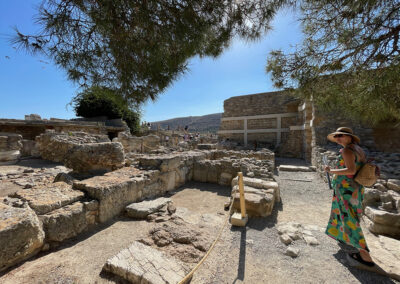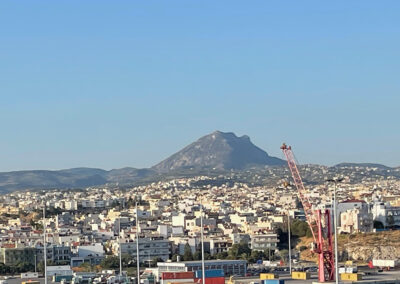Turkey and Greek Islands
Cruising the Aegean
Getting There
Lesbos | Mykonos | Kuşadasi and Ephesus | Patmos | Rhodes | Cyprus | Antalya | Bodrum | Crete
Getting Home
Crete
June 20 was our last full day of the cruise, and I think we approached this with mixed emotions. We had enjoyed getting to know new people, we had visited new and beautiful places, we had thoroughly enjoyed the ship, and we were tired. It was time to leave this life and get back to the home front.
The ship docked in Heraklion, on the north shore of Crete, around 8:00, but I couldn’t find a good vantage point for a photograph. Luckily Judy got this shot when she returned to the Grandeur later in the day. That’s a seventeenth-century fortress in the background, built by the Venetians when they controlled the island in the 1600s. Not long after docking we duly made our way to our respective excursions for the day. Judy’s trip was billed as “Minoan Gastronomy through History,” and again, and she was very excited telling me about it when we met again in the afternoon. Unfortunately her experience didn’t seem to match up with the expectations she had after reading the description of the excursion online. Here’s what she has to say about her day in Heralion, Crete.
Perhaps rather than critique the experience, I should critique the tour description. Minoan Gastronomy through History implies food and cooking over a period of time, not just early method and recipe. So, I was surprised when the bus pulled up to a summer riding camp for children. Lovely setting, children laughing and playing and the unmistakable aroma of horse de jour. The guide, adult daughter of the family, informed the rather large group that her parents had bought several contiguous parcels of land to create the camp and the Minoan “village.”
One parcel had an Minoan amphitheater and several large rocks resembling animals. It was thought (I don’t know by whom} the early Minoans worshiped them. We rested on the rocks (temperature about 100 degrees) as she gave a brief history. Still no food. As we walked to a yet unknown destination within the camp, the guide pointed out several very large, very old olive trees. The father had bought them and had them moved and transplanted to this site; some were so large they had to be topped to pass under bridges on their journey.
Finally we happened on a long ancient looking partially open front building with rush roof and tree branch beams. The structure had several “rooms” for storage, the housing of livestock, and a workroom with an interesting loom with the thread being secured with rocks at the ends. Next was a cookroom with a long fire-fueled cooktop. At last, a hint of gastronomy. As mother cooked, we sat a long tables and were served what I would call pita. There was olive oil for dipping but no plates or napkins until daughter ran to retrieve some from the restaurant where we would eventually be served what I would call traditional Greek food: fresh salad, roasted vegetables, rice, chicken (baked, maybe} all very good. Afterwards, we were free to walk around the site or visit the gift shop, which I’m sure was not in the Minoan vocabulary.
While basically a pleasant outing, the tour made me feel rather cheated. I am in no way a history buff, but i do find the history of other cultures fascinating and this tour did not fascinate me. I eased my disappointment by having a cocktail on the ship when I returned.
While Judy was enjoying her day in one way, I went with a small group for a tour of the Palace of Knossos, an archaeological site I had missed on our first trip to the Greek islands in the 1990s. I didn’t know much about the Minoan civilization before we started. My knowledge of ancient cultures was pretty much limited to Greco-Roman sites, and I suppose Ephesus was the earliest of excavated ancient sites I had actually been in. That was about to change when I stepped out of the van we were on and along with about 16 fellow passengers from the ship entered the gates of the Palace excavation.
The Palace of Knossos is a Minoan site, with some of the ruins dating from 1900 BC, though most are from buildings constructed after an earthquake destroyed the place around 1700 BC. So much for Ephesus being my most ancient city to visit. Apparently life went on swimmingly in the Minoan civilization both here and in other sites in the eastern Mediterranean for quite some time before the inevitable happened. Natural disasters took their toll, other culture arose, the Minoans were overtaken, their cites fell into ruin, and centuries of further natural catastrophes, buried even those ruins. Surviving texts mentioned the site on Crete, and in 1873, after Ottomans left the island (defeat is a bitter pill), following clues in those ancient texts, A British Archaeologist, Sir Arthur Evans, started digging in an olive grove in the hills above Heraklion and discovered this place, know known as the Palace of Knossos. For the next few decades further excavations were madd, and some enterprising and well-meaning groups started some reconstructions of some buildings, basing their work on ideas of Bronze Age life as they understood it.
(Once again I was fascinated with what I learned from our knowledgeable guide and just had to rehearse it by writing it down.)
Our small group had an excellent guide, and that made the entire visit much more enjoyable. As I did with my description of walking through Ephesus, I’m not going to give a blow-by-blow account. I’ve added captions to some of the photographs where I remember something to say. The only thing that might require a full sentence is that in the room now referred to as the King’s chamber, there is a stone “throne” that has been identified as the oldest surviving chair from an ancient civilization, a “chair” meaning something to sit on that has a back.
Here endeth the lesson.
Once we were back on board the Grandeur, we discovered that our luggage had been retrieved and placed on the bed. Taking the hint, we started packing, and after our final meal on board, finished up that task and put the luggage out in the passageway for pickup. Little did we know that what should have been a simple flight home the next morning would bring us more adventures than we had had on the entire cruise.
Judy’s Photos
Jim’s Photos
Getting There
Lesbos | Mykonos | Kuşadasi and Ephesus | Patmos | Rhodes | Cyprus | Antalya | Bodrum | Crete
Getting Home

